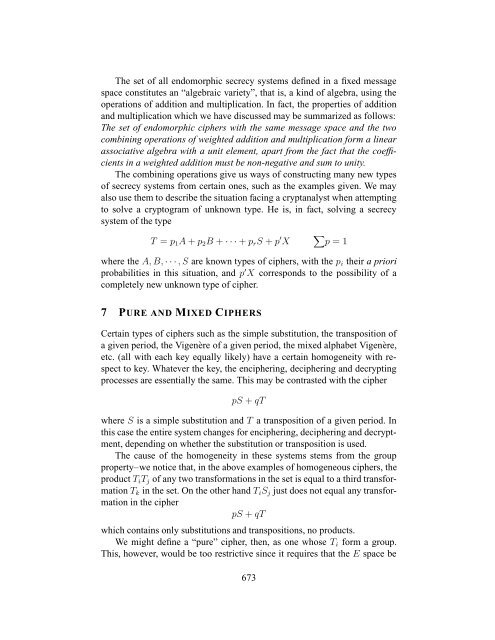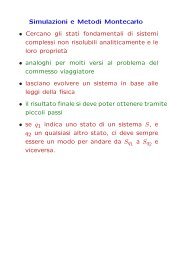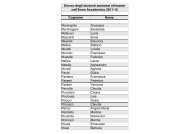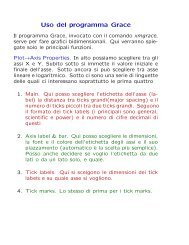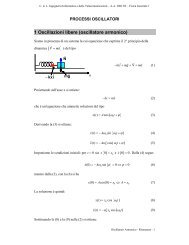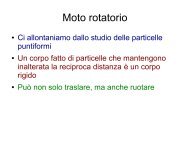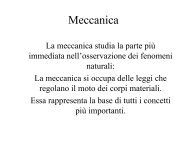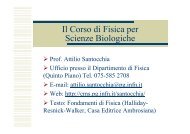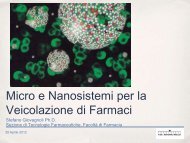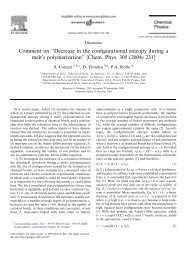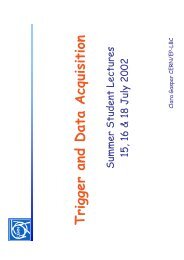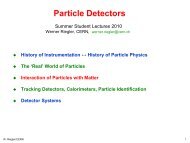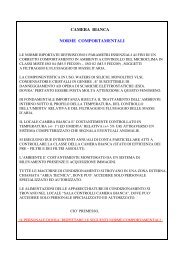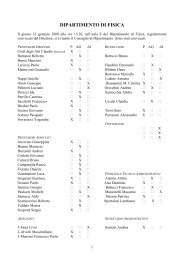Communication Theory of Secrecy Systems - Network Research Lab
Communication Theory of Secrecy Systems - Network Research Lab
Communication Theory of Secrecy Systems - Network Research Lab
You also want an ePaper? Increase the reach of your titles
YUMPU automatically turns print PDFs into web optimized ePapers that Google loves.
The set <strong>of</strong> all endomorphic secrecy systems defined in a fixed message<br />
space constitutes an “algebraic variety”, that is, a kind <strong>of</strong> algebra, using the<br />
operations <strong>of</strong> addition and multiplication. In fact, the properties <strong>of</strong> addition<br />
and multiplication which we have discussed may be summarized as follows:<br />
The set <strong>of</strong> endomorphic ciphers with the same message space and the two<br />
combining operations <strong>of</strong> weighted addition and multiplication form a linear<br />
associative algebra with a unit element, apart from the fact that the coefficients<br />
in a weighted addition must be non-negative and sum to unity.<br />
The combining operations give us ways <strong>of</strong> constructing many new types<br />
<strong>of</strong> secrecy systems from certain ones, such as the examples given. We may<br />
also use them to describe the situation facing a cryptanalyst when attempting<br />
to solve a cryptogram <strong>of</strong> unknown type. He is, in fact, solving a secrecy<br />
system <strong>of</strong> the type<br />
T = p1A + p2B + · · · + prS + p ′ X<br />
p = 1<br />
where the A, B, · · · , S are known types <strong>of</strong> ciphers, with the pi their a priori<br />
probabilities in this situation, and p ′ X corresponds to the possibility <strong>of</strong> a<br />
completely new unknown type <strong>of</strong> cipher.<br />
7 PURE AND MIXED CIPHERS<br />
Certain types <strong>of</strong> ciphers such as the simple substitution, the transposition <strong>of</strong><br />
a given period, the Vigenère <strong>of</strong> a given period, the mixed alphabet Vigenère,<br />
etc. (all with each key equally likely) have a certain homogeneity with respect<br />
to key. Whatever the key, the enciphering, deciphering and decrypting<br />
processes are essentially the same. This may be contrasted with the cipher<br />
pS + qT<br />
where S is a simple substitution and T a transposition <strong>of</strong> a given period. In<br />
this case the entire system changes for enciphering, deciphering and decryptment,<br />
depending on whether the substitution or transposition is used.<br />
The cause <strong>of</strong> the homogeneity in these systems stems from the group<br />
property–we notice that, in the above examples <strong>of</strong> homogeneous ciphers, the<br />
product TiTj <strong>of</strong> any two transformations in the set is equal to a third transformation<br />
Tk in the set. On the other hand TiSj just does not equal any transformation<br />
in the cipher<br />
pS + qT<br />
which contains only substitutions and transpositions, no products.<br />
We might define a “pure” cipher, then, as one whose Ti form a group.<br />
This, however, would be too restrictive since it requires that the E space be<br />
673


